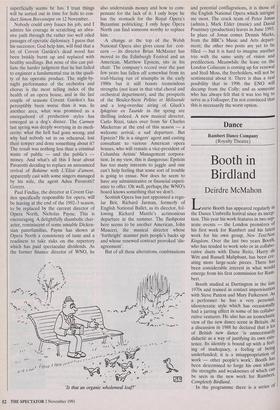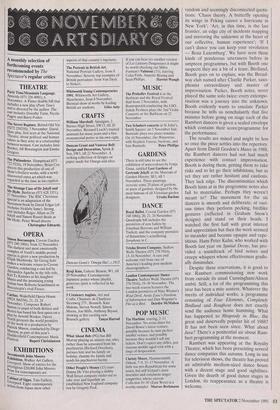Dance
Booth in Birdland
Deirdre McMahon
Laurie Booth has appeared regularly in the Dance Umbrella festival since its incep- tion. This year his work features in two sep- arate events — the London premieres of his first work for Rambert and his latest work for his own group, New Text/New Kingdom. Over the last two years Booth, who has tended to work solo or in collabo- rative duets with Dana Reitz, Harry de Witt and Russell Maliphant, has been cre- ating more large-scale pieces. There has been considerable interest in what would emerge from his first commission for Ram- bert.
Booth studied at Dartington in the late 1970s and trained in contact improvisation with Steve Paxton and Mary Fulkerson. As a performer he has a very personal, idiosyncratic style which has occasionallY had a jarring effect in some of his collabo- rative ventures. He also has an iconoclastic view of the new dance scene in Britain. At a discussion in 1988 he declared that a lot of British new dance 'is unnecessarily didactic as a way of justifying its own exis- tence. Its identity is bound up with a feel- ing of inadequacy, a feeling of being, underfunded; it is a misappropriation 01 work — other people's work'. Booth has been determined to forge his own idiom, the strengths and weaknesses of which can be seen in the new work for Rambert, Completely Birdland.
In the programme there is a series of
random and seemingly disconnected quota- tions: 'Chaos theory. A butterfly opening its wings in Peking causes a hurricane in New York'; 'Art, in this time, is the last frontier, an edge city of incidents mapping and mirroring the unknown at the heart of our collective, human experience'; 'If I can't dance you can keep your revolution
Rosa Luxemburg'. We have seen these kinds of ponderous utterances before in umpteen programmes, but with Booth one suspects they are a bit of a tease. Birdland, Booth goes on to explain, was the Broad- way club named after Charlie Parker, saxo- phonist extraordinary and master of improvisation. Parker, Booth notes, never played the same solo twice: every extempo- risation was a journey into the unknown. Booth evidently wants to emulate Parker because he tells us nonchalantly that five minutes before going on stage each of the Rambert dancers is given a sealed envelope which contains their score/programme for the performance.
The results are mixed and might be less so once the piece settles into the repertory. Apart from David Gordon's Mates in 1988, the Rambert dancers had not had much experience with contact improvisation. Booth is daring them, getting them to take risks and to let go their inhibitions, but as yet they are rather hesitant and cautious. They lack edge. The discontinuities which Booth hints at in the programme notes also fail to materialise. Perhaps they weren't meant to? The movement for the six dancers is smooth and deliberate; at vari- ous times they perform pecking, birdlike gestures (reflected in Graham Snow's designs) and stand on their heads. I watched the first half with great interest and appreciation but then the work seemed to meander and become opaque and repe- titious. Hans Peter Kuhn, who worked with Booth last year on Spatial Decay, has pro- vided a soundtrack of bird noises and creepy whispers whose effectiveness gradu- ally diminishes.
Despite these reservations, it is good to see Rambert commissioning new work from outside its usual Cunningham/Alston ambit. Still, a lot of the programming this year has been a mite austere. Whatever the merits of individual works, a programme consisting of Four Elements, Completely Birdland and Roughcut does not exactly send the audience home humming. What has happened to Rhapsody in Blue, the great and deservedly popular hit of 1988? It has not been seen since. What about Java? There's a penitential air about Ram- bert programming at the moment.
Rambert was appearing at the Royalty Theatre, which has been presenting several dance companies this autumn. Long in use for television shows, the theatre has proved an admirable medium-sized dance house with a decent stage and good sightlines. Given the dearth of good dance stages in London, its reappearance as a theatre is welcome.



































































 Previous page
Previous page